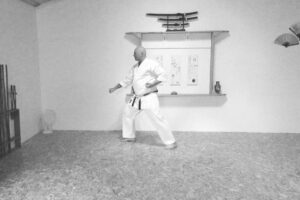 Gichin Funakoshi and his son Yoshitaka “Gigo” Funakoshi, are said to be the creator of the Taikyoku Katas around 1935-40. Some claim that Shigeru Egami and Hironishi Genshin also were involved in the creation.
Gichin Funakoshi and his son Yoshitaka “Gigo” Funakoshi, are said to be the creator of the Taikyoku Katas around 1935-40. Some claim that Shigeru Egami and Hironishi Genshin also were involved in the creation.
Taikyoku can be translated into:
- Great culmination.
- Great education.
- First Cause or First Course.
- Basic Ultimate.
- Taiji; in the Chinese language.
I prefer to use the word “Universal” for the translation of Taikyoku.
So far, I have seen six different Taikyoku Kata, but Gichin Funakoshi mentions only three of them in the book Karate-do Kyohan. These are Taikyoku Shodan, Nidan and Sandan. Even others claim that there were ten Katas from the beginning!
Why create new simple Katas?
Itosu had already done the job by creating the Heian/Pinan Katas for introduction in the Okinawan School around 1900. Those Katas were already simplified.
Therefore, the big question is!
Are the Taikyoku Katas necessary?
In my opinion, yes, the basic idea with the Kata is useful, if the basic meaning was to have Kata with variable techniques! Kind of Kihon Kata, or even more simplified Kata for Children.
My way of using the Kata may be different from others. First of all, I use the Kata to teach the pattern to beginners, which makes it easier to learn the Heian/Pinan Kata later on. I also use Taikyoku to teach new students the basic techniques, e.g. Age-uke, Ushi-uke, Gedan-uke, Mae-geri … The basic Kata is also good for practicing combinations of techniques. This, in my opinion, is the way the Taikyoku Kata should be used. The Taikyoku are experimental Katas! You can change the techniques just as you wish.
Of course, it is always a good idea to have basic Taikyoku Kata with predetermined techniques.
Do you have an opinion about the Taikyoku Kata? Let me hear it!
Thanks for reading.
Gert
